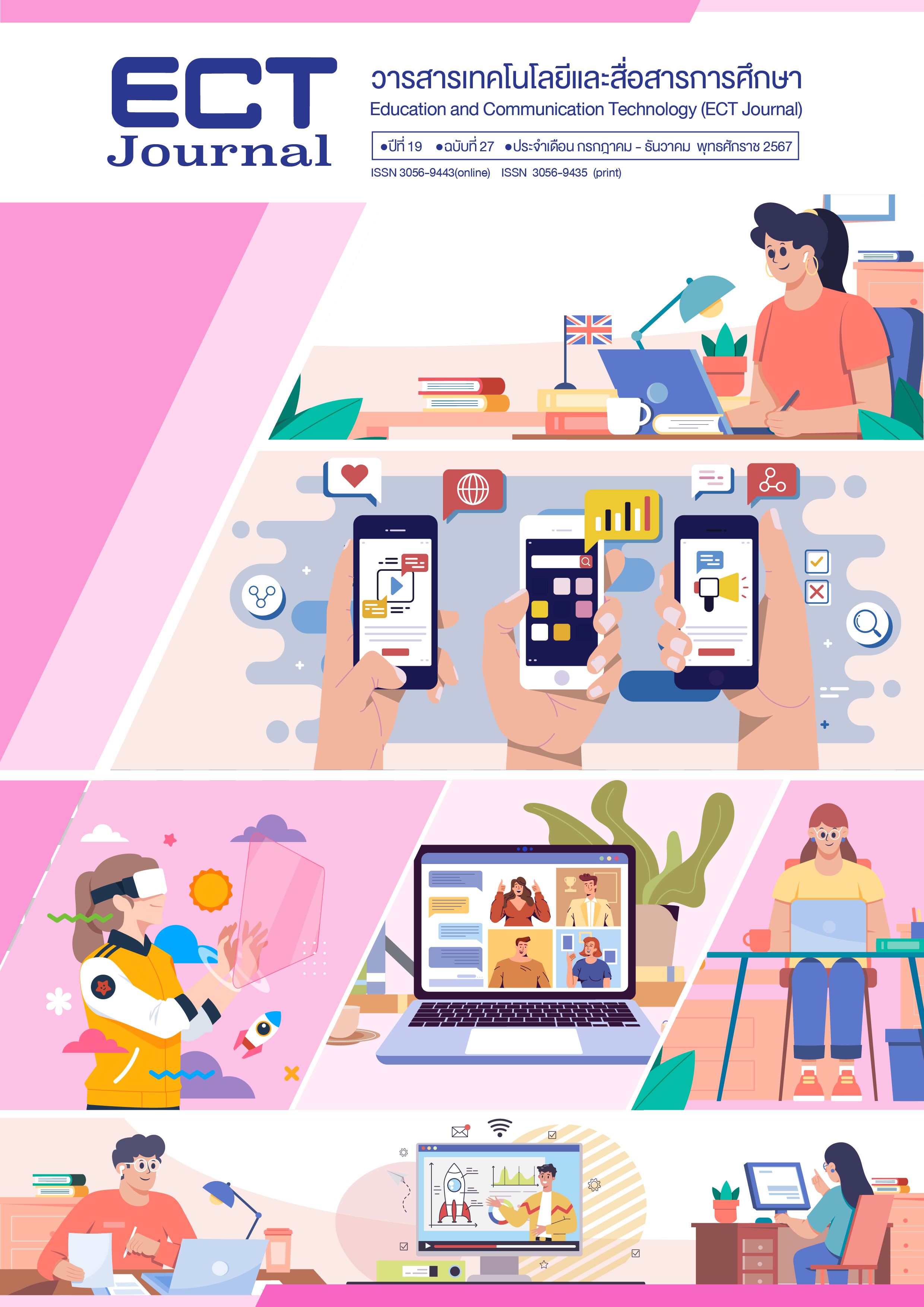A Virtual Reality (VR) Card Game Using Discovery Learning to Enhance Environmental Literacy
Keywords:
card game, virtual reality technology, discovery learning, environmental literacyAbstract
This research aims to: 1) study and develop a Virtual Reality (VR) card game using discovery learning to promote environmental literacy, and 2) examine the effects of using the VR card game with discovery learning on promoting environmental literacy. The sample group included five experts and 30 high school students, selected through purposive sampling. Research instruments included the VR card game, expert interviews, a quality assessment form for the VR card game, and an environmental literacy test. Statistical analysis methods included the percentage, mean, standard deviation, dependent t-test, and correlation coefficient.
The research findings revealed that: 1) the developed card game comprised the content, virtual reality simulation, card gameplay, and discovery learning. The overall quality assessment of the VR card game using discovery learning was rated very high (x̄=4.68, S.D. = 0.51). 2) The use of the VR card game showed that the average post-experiment environmental knowledge scores were significantly higher than the pre-experiment scores at the .05 significance level. 3) The comparison of the average post-experiment environmental attitude scores showed a significant increase at the .05 significance level. 4) The study of environmental behavior indicated that the post-experiment scores were significantly higher than the pre-experiment scores at the .05 significance level.
References
วรรนิสา หนูช่วย, และประกอบ กรณีกิจ. (2561). การเรียนรู้โดยใช้โครงงานเป็นฐานด้วยสื่อสังคมออนไลน์เพื่อส่งเสริมการรู้ด้านสิ่งแวดล้อมของนักเรียนมัธยมศึกษาตอนปลาย. วารสารการวิจัยการศึกษา, 12(2), 50-65. https://he02.tci-thaijo.org/index.php/Veridian-E-Journal/article/view/150963
Altin, A., Tecer, S., Tecer, L., Altin, S., & Kahraman, F. B. (2014). Environmental awareness level of secondary school students: A case study in Balıkesir (Türkiye). Procedia - Social and Behavioral Sciences, 141, 1208-1214. https://doi.org/10.1016/j.sbspro.2014.05.207
Barboza, G. L., Cózar, A., Gimenez, C. B., Gimenez, L. T., Kershaw, J. P., & Guilhermino, L. (2019). Macroplastics pollution in the marine environment. In C. Sheppard (Ed.), World seas: An environmental evaluation (pp. 305-328). Academic Press. https://doi.org/10.1016/b978-0-12-805052-1.00019-x
Bruner, J. (1966). Toward a theory of instruction. Harvard University Press.
Chen, C. H. (2020). Virtual reality in environmental education: The role of VR in enhancing environmental awareness and engagement. Journal of Environmental Education, 51(2), 123-135. https://doi.org/10.1080/00958964.2020.1717188
Dewi, R. S., Nurmilawati, M., & Budiretnani, A. D. (2017). Improving of scientific literacy ability using discovery learning model at the seventh-grade students of state JHS 3 Ngronggot Nganjuk-Indonesia. Journal Pendidikan Biologi Indonesia, 3(3), 266-271. https://doi.org/10.22219/jpbi.v3i3.4597
Fauville, G., Lantz-Andersson, A., & Säljö, R. (2020). The potential of using virtual reality technology in environmental education. Environmental Education Research, 26(4), 518-538. https://doi.org/10.1080/13504622.2020.1738346
Franco Mariscal, A. J., Ortega, J. M., & Benítez, M. P. (2012). Teaching the nature of science through the learning of chemical equilibrium. Science & Education, 21(7), 961-988. https://doi.org/10.1007/s11191-011-9442-9
Frantz, M. C., & Mayer, S. F. (2014). The importance of connection to nature in assessing environmental education programs. Studies in Educational Evaluation, 41, 85-89. https://doi.org/10.1016/j.stueduc.2013.10.001
Ibáñez, M. B., Di Serio, Á., Villarán, D., & Delgado-Kloos, C. (2020). Experimenting with electromagnetism using augmented reality: Impact on flow student experience and educational effectiveness. Computers & Education, 71, 1-13. https://doi.org/10.1016/j.compedu.2013.09.004
Kinney, P. L. (2018). Interactions of climate change, air pollution, and human health. Current Environmental Health Reports, 5(1), 179-186. https://doi.org/10.1007/s40572-018-0188-x
Liu, Z., & Chen, P. (2013). An exploration of the use of card games for teaching students in learning computer network concepts. Computers & Education, 68, 441-451. https://doi.org/10.1016/j.compedu.2013.06.010
Makransky, G., Borre-Gude, S., & Mayer, R. E. (2021). Motivational and cognitive benefits of training in immersive virtual reality based on multiple assessments. Journal of Computer Assisted Learning, 37(3), 759-773. https://doi.org/10.1111/jcal.12520
Markowitz, D. M., & Bailenson, J. N. (2018). Virtual reality and the built environment: A critical review. Building Research & Information, 46(4), 444-459. https://doi.org/10.1080/09613218.2017.1356128
Orr, D. W. (1992). Ecological literacy: Education and the transition to a postmodern world. State University of New York Press.
United Nations. (1997). A new blueprint for international action on the environment.
Downloads
Published
How to Cite
Issue
Section
License
Copyright (c) 2024 มหาวิทยาลัยสุโขทัยธรรมาธิราช

This work is licensed under a Creative Commons Attribution-NonCommercial-NoDerivatives 4.0 International License.
1. ทรรศนะและข้อคิดเห็นใด ๆ ที่ปรากฏอยู่ในวารสาร ECT Education and Communication Technology Journal เป็นของผู้เขียนโดยเฉพาะ สำนักเทคโนโลยีการศึกษา มหาวิทยาลัยสุโขทัยธรรมาธิราช และกองบรรณาธิการไม่จำเป็นต้องเห็นพ้องด้วย
2. กองบรรณาธิการของสงวนลิขสิทธิ์ในการบรรณาธิการข้อเขียนทุกชิ้น เพื่อความเหมาะสมในการจัดพิมพ์เผยแพร่






